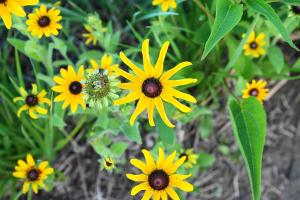This is my second post on plant knowledge from a series of five all detailing different the parts of plants that you may or may not know, using all the notes I wrote and collected when I did my RHS course.
Let me know what you think – interesting, boring or just indifferent I’d really like to know.
As an extra challenge I’m going to see if I can get each post under 500 words. Don’t count me though


Courtesy of Jazzi
Part Two – Plant Terms
Sometimes I get asked what is the difference between an annual, biennial, perennial, and the less known, ephemeral plant?
All the above are types of plant definitions. They tell you in effect how long the plant will last:
Annual
A plant that last just one year. Their complete growing cycle from seed, to seedling, to plant, to flower, to set seed again is done and dusted in just one year. Pretty niffy but it means the plants work really hard in a short space of time to ensure the next generation of plant carries on the good work.
Examples of annuals include mostly (not always exclusively) plants that end up with either seed pods or flower heads, and can very often be found in the kitchen garden:
- Sweetcorn
- Peas
- Petunias
- Pansies
- Lobelia
If you have to keep replacing the plant every yr then it’s very probably a type of annual.
Biennial
These are the guys that take up to two years to show their flowers. The first year is spent germinating, growing and generally building up some good leaves and roots while in the second year the plant is ready to give it’s best show. Once they’ve given it their all they tend to die back. Those that do come back don’t tend to flower as well so like annuals often get replaced after the second year.
- Foxgloves
- Campanulas (Canterbury Bells)
- Myosotis (Forget-me-Nots)
- Parsley
- Poppies (some varieties)
Ephemeral
Another word for fast, these plants can grow like nobodies business and get flowering and gone before anyone even notices – it’s that quick. It also means that by working at such a pace the variety can quickly populate an area and make itself well known and can become evasive. Definitions are slightly different depending on which side of the Atlantic you come from but the RHS, while great at giving a definition of the term aren’t so great at listing examples however I think it’s fair to say there are probably quite a few unwanted plants in the garden (aka weeds) that would fall under this term, as would annuals because in some cases they do indeed grow and flower in the same yr;
- Stellaria media (Chickweed)
- Senecio vulgaris L. (Groundsel)
- Meadow grasses
Perennial
Ah this, along with the annuals, make up the majority of plants you see in your cultivation space. A perennial plant is one that germinates, grows, might flower, might fruit but then it goes to sleep all in the first year, and the rest of the plant dies off. That may be the leaves or it may be the whole plant in the case of a flowering bulb. The second and subsequent years the same plant with start growing again (once the conditions are right), flowers, fruits and then heads back indoors again. Year after year. In the case of trees this could go on for hundreds of years. Each new seasons more growth will be added until the plant reaches it’s full size and it’s happy to just sit doing what it does best – making the space look good in the summer months, while saving energy in the cold months!
Examples would include;
- Apple trees
- Blackcurrants
- Fuchsias
- Delphinniums
All plants fall under one (or often more) of these terms. Most garden centres also split their plants into the different terms – annuals are usually found at the front as you walk in, perennials to the back (usually in alphabetical plant name).
Cover photo courtesy of Bob Fornal
